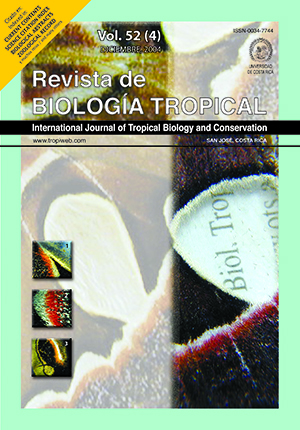Abstract
The plant Tagetes lucida Cav. (syn. T. florida Sweet, T. schiedeana Less.) is an aromatic herb distributed naturally from Mexico to Honduras, at elevations between 1 000 and 2 000 m. It is used as a spice, for medicine, as insecticide and as ornamental plant. It is cultivated commercially in Costa Rica as a spice herb; it contains an oil having an anise-like odor, and the fresh aerial parts of this plant are sold in the supermarket as a substitute of tarragon (Artemisia dracunculus L.). The essential oils isolated from aerial parts bought, at May and October, in a supermarket in San José (Costa Rica). Fresh flowering aerial parts, flowers and leaves plus stems, were subjected to hydrodistillation for 3 hr using a modified Clevenger-type apparatus. The distilled oils were collected and dried over anhydrous sodium sulphate and stored in a freezer (0-10°C). The light yellow green oil yield was about 0.07% (v/w). GC/MS analyses were performed using a Shimadzu GCMS-QP5050 apparatus and CLASS 5000 software with Wiley 139 computer database. Identification of the components of the oil was performed using the retention indices, which were calculated in relation to a homologous series of hydrocarbons, and by comparison of their mass spectra with those published in the literature or those of our own database. Thirty compounds were identified, of which methyl chavicol (95-97%) was the major constituent. From flower oil, two bithienyls were detected as minor constituents.References
Abdala, L.R. 1999. Flavonoids of the Aerial Parts from Tagetes lucida (Asteraceae). Biochem. Syst. Ecol. 27: 753-754.
Adams, R.P. 1995. Identification of Essential Oil Components by Gas Chromatography/Mass Spectroscopy. Allured. Carol Stream, IL.
Adams, R. P. 2001. Identification of Essential Oil Components by Gas Chromatography/Quadrupole Mass Spectroscopy. Allured. Carol Stream IL.
Anonymous, 1938. Oil of Tagetes lucida Cav. Parfums France 16: 28 (From NAPRALERT Database).
Aquino, R., A. Cáceres, S. Morelli & L. Rastrelli. 2002. An extract of Tagetes lucida and its phenolic constituents as antioxidants. J. Nat. Prod. 65: 1773-1776.
Bauer, K., D. Garbe & H. Surburg. 1990. Common Fragrance and Flavor Materials. Preparation, Properties and Uses. VHC, Weinheim.
Bicchi, C., P. Rubiolo, M. Fresia & Ch. Franz. 1994. On the composition of Tagetes lucida Cav. essential Oil. 25th International Symposium on Essential Oils, Grasse, France.
Bohlmann, F., T. Burkhardt & C. Zdero. 1973. Naturally occurring acetylenes. Academic, London.
Browner, C.H. 1985. Plants Used for Reproductive Health in Oaxaca, Mexico. Econ. Bot. 39: 482-504.
Bye, R.A. 1986. Medicinal Plants of the Sierra Madre: Comparative Study of Tarahumara and Mexican
Market Plants. Econ. Bot. 40: 103-134.
Cáceres, A., M. Torres, S. Ortiz, F. Cano & E. Jáuregui. 1993a. Plants Used in Guatemala for the Treatment of Gastrointestinal Disorders. IV. Vibriocidal Activity of Five American Plants Used to Treat Infections. J. Ethnopharmacol. 39: 73-75.
Cáceres, A., L. Fletes, L. Aguilar, O. Ramírez, L. Figueroa, A.M. Taracena & B. Samayoa. 1993b. Plants Used in Guatemala for the Treatment of Gastrointestinal Disorders. III. Confirmation of Activity Against Enterobacteria of 16 Plants. J. Ethnopharmacol. 38: 31-38.
Cáceres, A., O. Cano, B. Samayoa & L. Aguilar. 1990. Plants Used in Guatemala for the Treatment of
Gastrointestinal Disorders. I. Screening of 84 Plants Against Enterobacteria. J. Ethnopharmacol. 30: 55-73.
Cáceres, A. 1996. Plantas de Uso Medicinal en Guatemala. Editorial Universitaria, Guatemala, p. 305-307.
Chan, G.F.Q., M.M. Lee, J. Glushka & G.H.N. Towers. 1979. Photosensitizing Thiophenes in Porophyllum, Tessaria and Tagetes. Phytochemistry 18: 1566.
De Vincenzi, M., M. Silano, F. Maialetti & B. Scazzocchio. 2000. Safety data review. Constituents of aromatic plants: II. Estragole. Fitoterapia 71: 725-729.
Garg, S.N., S.K. Verma & S. Kumar. 1999. Identification of the Volatile Constituents in the Capitula Oil of Tagetes patula L. Grown in the North Indian Plains. J. Essent. Oil Res. 11: 688-690.
Girón, L., M.V. Freire, A. Alonzo & A. Cáceres. 1991. Ethnobotanical Survey of the Medicinal Flora Used by the Caribs of Guatemala. J. Ethnopharmacol. 34: 173-187.
Guzmán, A. & A. Manjarrez. 1962. Estudio del aceite esencial de Tagetes florida. Bol. Inst. Quím. Univ. Nal. Autón. Méx. 14: 48-54.
Lawrence, B.M. 1985. Essential oils of the Tagetes Genus. Perfumer & Flavorist 10: 73-82.
Lawrence, B.M. 2000. Progress in Essential Oils. Perfumer & Flavorist 25: 32-49.
Masada,Y. 1976. Analysis of Essential Oils by Gas Chromatography and Mass Spectrometry. Wiley, New York.
McLafferty, F.W. 1993. Registry of Mass Spectral Data. Wiley. New York.
Morton, J.F. 1981. Atlas of Medicinal Plants of Middle America. Bahamas to Yucatan. C.C. Thomas,
Springfield, IL.
Rios, T. & M. Flores. 1976. Estudio Químico de los Tagetes. I. Rev. Latinoamer. Quím. 7: 33-36.
Sørensen, N.A. 1977. Polyacetylenes and conservatism of chemical characters in the Compositae. In V.H. Heywood, J.B. Harborne & B.L. Turner (eds.). The Biology and Chemistry of the Compositae Academic. London. Vol. 1, Chapter 13.
Strother, J.L. 1977. Tageteae-systematic review. Chapter 27. In V.H. Heywood, J.B. Harborne & B.L. Turner (eds.). The Biology and Chemistry of the Compositae. Academic, London. Vol. 2.
Tucker, A.O. & M.J. Maciarello. 1996. Volatile Leaf Oil of Tagetes lemmonii Gray. J. Essent. Oil Res. 8:
-418.
Vila, R., J. Iglesias, S. Cañigueral & J.F. Cicció. 2000. Essential oil of Tagetes filifolia Lag. from Costa Rica. Ing. Cienc. Quím. 19: 13-14.
Zygadlo, J.A., R.E. Abburra, D.M. Maestri, C.A. Guzmán, N.R. Grosso & L. Ariza-Espinar. 1993a. Essential Oil Composition of Tagetes terniflora H.B.K. and Tagetes laxa Cabrera. Flav. Frag. J. 8: 273-275.
Zygadlo, J.A., D.M. Maestri & L. Ariza-Espinar. 1993b. The Volatile Oil of Tagetes argentina Cabrera. J. Essent. Oil Res. 5: 85-86.
##plugins.facebook.comentarios##

This work is licensed under a Creative Commons Attribution 4.0 International License.
Copyright (c) 2004 Revista de Biología Tropical


